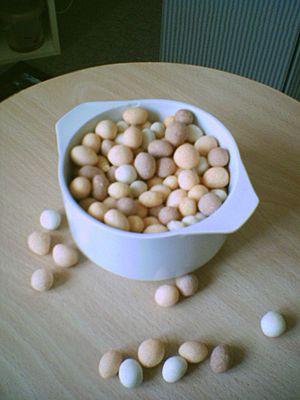Borrelnootje facts for kids
A borrelnootje (say "BOR-rel-noot-yeh") is a popular snack, especially in the Netherlands. It's usually a peanut covered in a crunchy, seasoned coating. Think of it like a peanut with a delicious, crispy shell! These tasty nuts often have a savory, herbal flavor.
Contents
Where Did Borrelnootjes Come From?
The First Crunchy Nuts
In the 1950s, a company called Go & Zoon (which later became Go-Tan) started making these special peanuts. They called their snack "Katjang Shanghai." This family business brought the idea from Indonesia. In Indonesia, similar spicy peanuts are known as kacang pedis.
Becoming Popular
Other companies soon noticed how popular these nuts were. Companies like Calvé and Duyvis began making their own versions. Calvé even paid Go-Tan to use their idea for making lots of these nuts. Duyvis, however, found their own unique way to produce them.
How Are Borrelnootjes Made?
The Crispy Coating
The crunchy layer around a borrelnootje is mostly made from starch. Sometimes, the nut inside might feel a bit loose from its coating. This can happen for a few reasons. One reason is that the dough around the nut might rise during cooking. Another reason is that moisture in the dough evaporates, making the coating shrink a little.
Different Kinds of Borrelnootjes
Borrelnootjes come in many exciting flavors and looks!
- Classic White Coating: This is the simplest borrelnootje. It has a white coating and often tastes like garlic. This was the original "sjanghainootje" flavor. Today's colorful borrelnootjes are based on this classic.
- Tiger Nuts: These are borrelnootjes where the crispy coating has several different colors, like stripes on a tiger! This fun version first appeared in the mid-1990s.
- Japanese Cocktail Nuts: You might find these in a "Japanese mix" snack bag. They have a smooth, hard coating and are usually a bit sweet.
- Oriental Cocktail Nuts: These borrelnootjes are packed with flavors like curry, cumin, onion, garlic, and coriander. They offer a rich, spicy taste.
Since the early 2000s, you can also buy bags with a mix of different borrelnootje flavors. This way, you can enjoy a variety of tastes in one snack!


